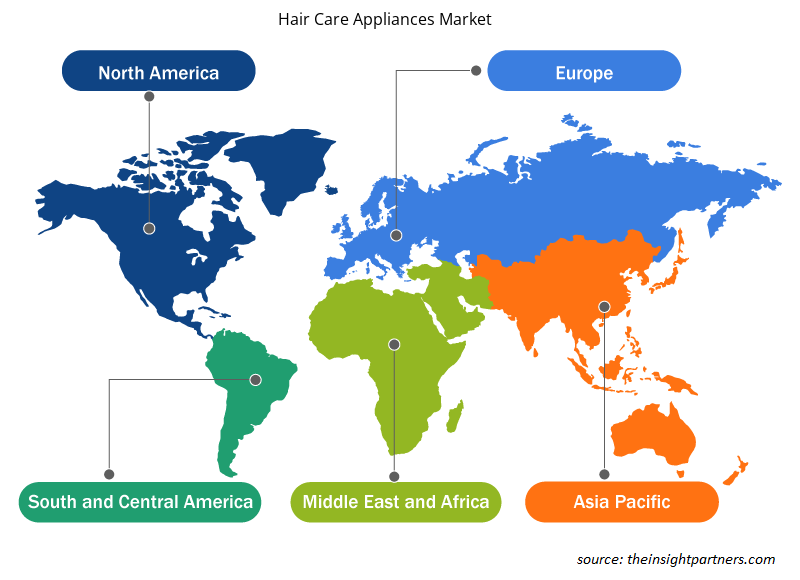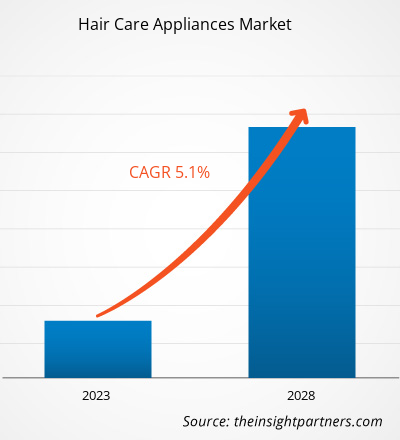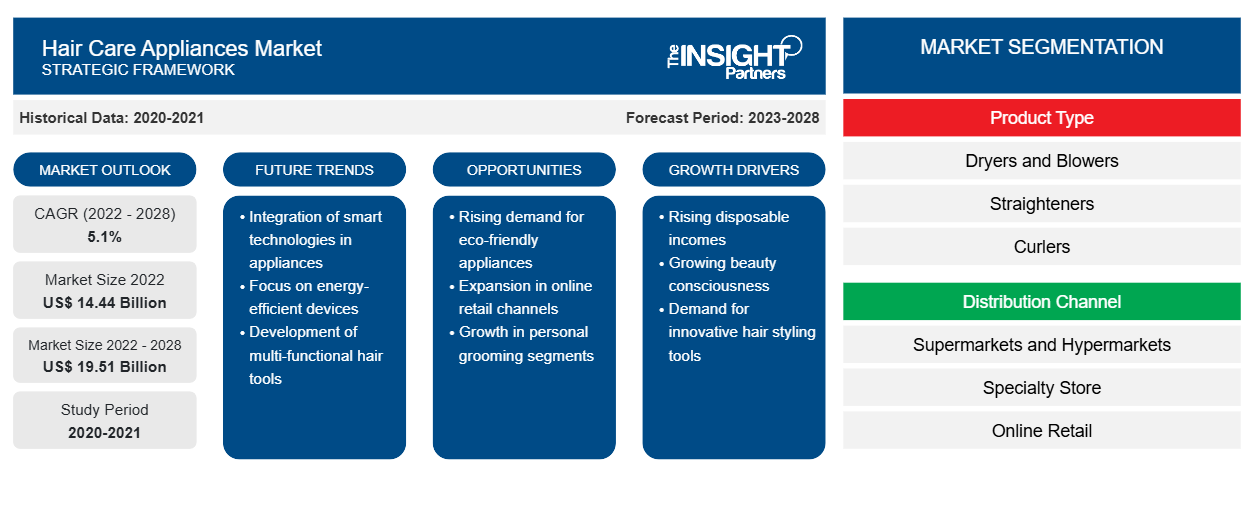Der Markt für Haarpflegegeräte soll von 14.440,23 Millionen US-Dollar im Jahr 2022 auf 19.512,86 Millionen US-Dollar im Jahr 2028 wachsen; von 2022 bis 2028 wird mit einer durchschnittlichen jährlichen Wachstumsrate von 5,1 % gerechnet.
Die wachsende Bedeutung von Körperpflege und persönlichem Erscheinungsbild hat die Nachfrage nach Haarpflegegeräten erhöht. Die Geräte helfen dabei, Haarschäden zu reduzieren und das Haar auf besondere Weise zu stylen.
Im Jahr 2021 dominierte der asiatisch-pazifische Raum den globalen Markt für Haarpflegegeräte . Das zunehmende Bewusstsein für Haargesundheit, der wachsende Einfluss sozialer Medien auf die Verbraucher und die steigende Verfügbarkeit von Haarpflegegeräten zu erschwinglichen Preisen treiben das Marktwachstum maßgeblich voran. Darüber hinaus entwickeln Hersteller von Haarpflegegeräten im asiatisch-pazifischen Raum innovative Haarpflegegeräte. So brachte Koninklijke Philips NV, Philips India im Juli 2020 eine Reihe hochtechnologischer Haarpflegegeräte wie Haarglätter und Haartrockner unter der Marke SenseIQ auf den Markt. Die Produkte verwenden aktive Sensoren, um die Temperatur des Haares beim Stylen zu messen. Mehrere Marktteilnehmer planen außerdem, mehr für Marketingaktivitäten auszugeben, um die Verbraucher auf ihr Produkt aufmerksam zu machen, was dem Markt im Prognosezeitraum Wachstumschancen bieten würde.
Passen Sie diesen Bericht Ihren Anforderungen an
Sie erhalten kostenlos individuelle Anpassungen an jedem Bericht, einschließlich Teilen dieses Berichts oder einer Analyse auf Länderebene, eines Excel-Datenpakets sowie tolle Angebote und Rabatte für Start-ups und Universitäten.
-
Holen Sie sich die wichtigsten Markttrends aus diesem Bericht.Dieses KOSTENLOSE Beispiel umfasst eine Datenanalyse von Markttrends bis hin zu Schätzungen und Prognosen.
Markteinblicke
Produktinnovationen bieten im Prognosezeitraum lukrative Wachstumschancen
Die Hersteller von Haarpflegegeräten investieren erheblich in die Entwicklung neuer Produkte, um innovative Produkte auf den Markt zu bringen, die den sich ändernden Anforderungen der Verbraucher gerecht werden. Verbraucher sind sehr besorgt über Haarschäden, die durch Heizgeräte verursacht werden. Daher entwickeln Hersteller Produkte mit Temperaturkontrolltechnologie, die das Haar auch nach längerem Gebrauch nur minimal schädigen. So brachte FOLLICLE, LLC im Januar 2020 kabellose, wiederaufladbare und intelligente Haartrockner mit patentierter SmartDry AI Tech-Technologie auf den Markt, die Temperatur und Lüftergeschwindigkeit steuert. Ebenso brachte SharkNinja Holding LLC, ein globaler Hersteller von Haushalts- und Schönheitsgeräten, im September 2021 den Shark HyperAIR-Haartrockner mit HyperAIR IQ-Technologie auf den Markt, der hochgeschwindigkeitserhitzte Luft und ionisierte Luft kombiniert, um ein schnelles Trocknen mit minimalen Hitzeschäden zu ermöglichen. Daher wird erwartet, dass die zunehmende Entwicklung innovativer Haarpflegegeräte verschiedener Hersteller dem Markt im Prognosezeitraum Wachstumschancen bietet.
Einblicke in Produkttypen
Basierend auf dem Produkttyp ist der Markt für Haarpflegegeräte in Trockner und Föhne, Glätteisen, Lockenstäbe und andere unterteilt. Im Jahr 2021 hatte das Segment Trockner und Föhne den größten Marktanteil. Ein Haartrockner ist ein elektromechanisches Gerät, das Umgebungs- oder Heißluft über feuchtes Haar bläst, um die Verdunstung des Wassers zum Trocknen des Haares zu beschleunigen. Föhne ermöglichen eine bessere Kontrolle über die Form und den Stil des Haares.
Revlon Inc., Koninklijke Philips NV, Dyson Limited, Jemella Ltd., Instyler, Kiss Products Inc., Toni & Guy, Cloud Nine, T3 Micro Inc. und Conair LLC sind einige der wichtigsten Akteure auf dem Markt für Haarpflegegeräte. Die großen Akteure verfolgen verschiedene Strategien, wie Fusionen und Übernahmen sowie Produkteinführungen, um ihre geografische Präsenz und Kundenbasis zu erweitern.
Regionale Einblicke in den Markt für Haarpflegegeräte
Die regionalen Trends und Faktoren, die den Markt für Haarpflegegeräte im Prognosezeitraum beeinflussen, wurden von den Analysten von Insight Partners ausführlich erläutert. In diesem Abschnitt werden auch die Marktsegmente und die Geografie von Haarpflegegeräten in Nordamerika, Europa, im asiatisch-pazifischen Raum, im Nahen Osten und Afrika sowie in Süd- und Mittelamerika erörtert.

- Holen Sie sich die regionalen Daten für den Markt für Haarpflegegeräte
Umfang des Marktberichts über Haarpflegegeräte
| Berichtsattribut | Details |
|---|---|
| Marktgröße im Jahr 2022 | 14,44 Milliarden US-Dollar |
| Marktgröße bis 2028 | 19,51 Milliarden US-Dollar |
| Globale CAGR (2022 - 2028) | 5,1 % |
| Historische Daten | 2020-2021 |
| Prognosezeitraum | 2023–2028 |
| Abgedeckte Segmente |
Nach Produkttyp
|
| Abgedeckte Regionen und Länder |
Nordamerika
|
| Marktführer und wichtige Unternehmensprofile |
|
Dichte der Marktteilnehmer für Haarpflegegeräte: Die Auswirkungen auf die Geschäftsdynamik verstehen
Der Markt für Haarpflegegeräte wächst rasant, angetrieben durch die steigende Nachfrage der Endverbraucher aufgrund von Faktoren wie sich entwickelnden Verbraucherpräferenzen, technologischen Fortschritten und einem größeren Bewusstsein für die Vorteile des Produkts. Mit steigender Nachfrage erweitern Unternehmen ihr Angebot, entwickeln Innovationen, um die Bedürfnisse der Verbraucher zu erfüllen, und nutzen neue Trends, was das Marktwachstum weiter ankurbelt.
Die Marktteilnehmerdichte bezieht sich auf die Verteilung der Firmen oder Unternehmen, die in einem bestimmten Markt oder einer bestimmten Branche tätig sind. Sie gibt an, wie viele Wettbewerber (Marktteilnehmer) in einem bestimmten Marktraum im Verhältnis zu seiner Größe oder seinem gesamten Marktwert präsent sind.
Die wichtigsten auf dem Markt für Haarpflegegeräte tätigen Unternehmen sind:
- Revlon Inc.
- Koninklijke Philips NV
- Dyson Limited
- Jemella Ltd.
- Instyler
Haftungsausschluss : Die oben aufgeführten Unternehmen sind nicht in einer bestimmten Reihenfolge aufgeführt.

- Überblick über die wichtigsten Akteure auf dem Markt für Haarpflegegeräte
Bericht-Spotlights
- Fortschrittliche Trends in der Haarpflegegerätebranche helfen den Akteuren bei der Entwicklung wirksamer langfristiger Strategien
- Von Unternehmen verfolgte Geschäftswachstumsstrategien zur Sicherung des Wachstums in entwickelten und sich entwickelnden Märkten
- Quantitative Analyse des globalen Marktes für Haarpflegegeräte von 2020 bis 2028
- Schätzung der Nachfrage nach Haarpflegegeräten in verschiedenen Branchen
- Pest-Analyse zur Veranschaulichung der Wirksamkeit von Käufern und Lieferanten in der Haarpflegegerätebranche
- Aktuelle Entwicklungen zum Verständnis der Wettbewerbssituation auf dem Markt und der Nachfrage nach Haarpflegegeräten
- Markttrends und -aussichten sowie Faktoren, die das Wachstum des Marktes bestimmen, einschließlich Treiber und Hemmnisse
- Verständnis der Strategien, die das kommerzielle Interesse am Wachstum des globalen Marktes für Haarpflegegeräte untermauern und den Entscheidungsprozess unterstützen
- Haartuchwickel Marktgröße an verschiedenen Marktknoten
- Detaillierte Übersicht und Segmentierung des Marktes für Haarpflegegeräte und seiner Branchendynamik
- Der Markt für Haarpflegegeräte ist in verschiedenen Regionen groß und bietet vielversprechende Wachstumschancen
Die „Marktanalyse für Haarpflegegeräte bis 2028“ ist eine spezialisierte und eingehende Studie der Konsumgüterindustrie mit besonderem Schwerpunkt auf der Trendanalyse des Marktes für Haarpflegegeräte. Der Bericht soll einen Überblick über den Markt mit detaillierter Marktsegmentierung geben. Der Markt für Haarpflegegeräte ist nach Produkttyp, Vertriebskanal und Geografie segmentiert. Basierend auf dem Produkttyp ist der Markt in Trockner und Föhne, Glätteisen, Lockenstäbe und andere unterteilt. Basierend auf dem Vertriebskanal ist der Markt in Supermärkte und Hypermärkte, Fachgeschäfte, Online-Einzelhandel und andere unterteilt. Basierend auf der Geografie ist der Markt für Haarpflegegeräte hauptsächlich in Nordamerika, Europa, Asien-Pazifik, den Nahen Osten und Afrika sowie Süd- und Mittelamerika segmentiert. Im Jahr 2021 hatte das Segment der Trockner und Föhne den größten Marktanteil und wird voraussichtlich auch im Prognosezeitraum das am schnellsten wachsende Segment sein.
Firmenprofile
- Revlon Inc.
- Koninklijke Philips NV
- Dyson Limited
- Jemella Ltd.
- Instyler
- Kiss Products Inc.
- Toni & Guy
- Wolke Sieben
- T3 Micro Inc.
- Conair LLC
- Historische Analyse (2 Jahre), Basisjahr, Prognose (7 Jahre) mit CAGR
- PEST- und SWOT-Analyse
- Marktgröße Wert/Volumen – Global, Regional, Land
- Branchen- und Wettbewerbslandschaft
- Excel-Datensatz
Aktuelle Berichte
Verwandte Berichte
Erfahrungsberichte
Grund zum Kauf
- Fundierte Entscheidungsfindung
- Marktdynamik verstehen
- Wettbewerbsanalyse
- Kundeneinblicke
- Marktprognosen
- Risikominimierung
- Strategische Planung
- Investitionsbegründung
- Identifizierung neuer Märkte
- Verbesserung von Marketingstrategien
- Steigerung der Betriebseffizienz
- Anpassung an regulatorische Trends























 Kostenlose Probe anfordern für - Markt für Haarpflegegeräte
Kostenlose Probe anfordern für - Markt für Haarpflegegeräte